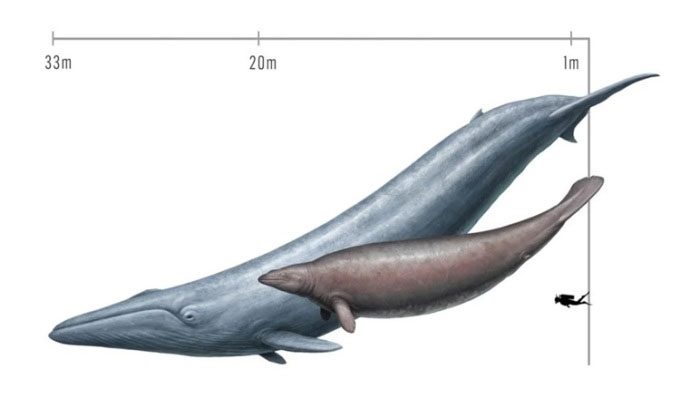New Research Reveals Ancient Whale Species Perucetus Was Huge, Yet Smaller Than Today’s Blue Whale.
Last August, a team of paleontologists announced the discovery of fossilized bones from a giant ancient whale species. According to them, the Perucetus whale could weigh over 200 tons, making it the heaviest animal to have ever lived on Earth. However, in a study published in the journal PeerJ, two scientists have dismissed that speculation. According to Nicholas Pyenson, a paleontologist at the Smithsonian National Museum of Natural History and one of the authors of the new study, that figure is nonsensical, as reported by Interesting Engineering on March 1.

Comparison of the sizes of the blue whale, extinct Perucetus whale, and humans. (Photo: Cullen Townsend)
Pyenson and Ryosuke Motani, a paleontologist at the University of California, Davis, concluded that the Perucetus could weigh between 60 to 70 tons, comparable to a sperm whale. They also analyzed the fossils of blue whales and provided a new weight estimate for the species. They concluded that blue whales can weigh up to 270 tons, significantly more than the previous estimate of 150 tons. Therefore, they are the heaviest species known in the history of the animal kingdom.
The Perucetus first attracted attention in 2010 when Mario Urbina, a paleontologist at the National University of San Marcos in Lima, Peru, stumbled upon a bone in the southern Peruvian desert. He and his colleagues excavated 13 vertebrae, 4 ribs, and a part of the pelvis. The bones exhibited many distinctive characteristics of whale bones but were unusually large and heavy. Urbina’s team reconstructed the entire skeleton of Perucetus by studying much smaller whale species that lived at the same time. They were also inspired by modern manatees, a species with a unique skeleton that allows them to sink underwater to graze on seagrass.
Urbina and his colleagues produced a reconstruction image of a peculiar animal. It featured a massive long trunk, a small head, flippers, and hind limbs. Motani, an expert in reconstructing the bodies of extinct marine animals, was quite puzzled by that conclusion. He reached out to Pyenson, a fossil whale expert. Both felt that modeling Perucetus based on manatees was a mistake, as only whales have evolved to such massive sizes.
In the new study, Pyenson and Motani examined existing whale species. Since no one has been able to accurately weigh a living blue whale, they reviewed data collected by Japanese whaling ships in the 1940s and used that information as a basis for their new estimates. They also created a 3D model of the blue whale, which served as a model for Perucetus. With this approach, they estimated Perucetus weighed between 60 to 70 tons, much less than earlier conclusions.
Eli Amson, a bone modeling expert at the Natural History Museum in Stuttgart, Germany, a co-author of the previous study, disagreed with the approach taken by Pyenson and Motani. According to him, the extinct blue whale had very different biological characteristics compared to recent whale species. He and his team are creating their own 3D model of the ancient animal. They found that Perucetus resembles manatees much more than initially thought, reinforcing the conclusion that it was equivalent to or heavier than blue whales.
Pyenson stated that Perucetus remains a significant discovery, even if it is smaller according to his and Motani’s conclusions. Paleontologists have long believed that whales evolved to massive sizes only in the last few million years. Even at 60 tons, Perucetus is still a giant among early whale species.



















































